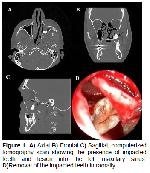Ectopic eruption of teeth from the oral cavity to other regionssuch as the nasal cavity, mandibular condyle, coronoid process, and palateis rare. The maxillary sinus cavities are one of the areas where teeth show ectopic eruption. The etiology of the ectopic eruption of teeth has not yet been fully elucidated, but many theories have been suggested, including pathological conditions such as trauma, infection, developmental anomalies, and dentigerous cysts. It is thought that the dental buds are displaced by the expansion of dentigerous cysts, causing the teeth to become ectopic
3,6-8.
Dentigerous cysts are the second most common cyst type to appear in jaws, after radical cysts. The majority (about 70%) of dentigerous cysts are found in the mandible, and a smaller proportion (about 30%) are found in the maxillary 3,4,7. Dentigerous cysts usually occur during the second or third decade of life and are rarely reported in childhood. However, according to some authors, most patients with dentigerous cysts are younger than 20. The age range of patients with dentigerous cysts in the literature varies from 4 to 57 years 3.
Dentigerous cysts are usually painless, but they cause swelling in the face and may cause delay in tooth eruption. When dentigerous cysts appear in the maxillary sinus, symptoms often occur in the late period. In these cases, the cysts can be detected by routine radiographic examination 3,8-11. In other cases, the classic symptoms of sinus disease are seen in patients with cysts, including swelling, facial pain, headaches, and nasolacrimal obstruction. Cysts that are large enough to cover the maxillary sinus put pressure on the sinus walls and may cause nasal and ophthalmologic disorders 3. Altas et al. 12 reported epiphora due to nasolacrimal duct pressure originating from a dentigerous cyst associated with an unerupted ectopic canine tooth in the maxillary sinus. Avitia et al. 13 reported a case of orbital proptosis originating from a dentigerous cyst associated with an unerupted ectopic tooth in the maxillary sinus.
There are also cases in the literature of dentigerous cysts that do not cause clinical symptoms. In radiological data, dentigerous cysts are seen as unilocular radiolucent cysts with well-defined sclerotic borders, and teeth are associated with the unerupted tooth crown. Waters radiography, orthopantomography, and plain skull radiography are useful and simple examination methods for clinical applications. Computed tomography can be used to determine the orbital or nasal invasion or involvement of a lesion. For this reason, computed tomography is not only necessary for a definitive diagnosis, but also an advantageous method for the evaluation of the related pathology, ectopic tooth localization, and determination of the appropriate treatment option 4,8,11.
In this case, we observed the cyst and impacted tooth attached to the inner lateral wall of the maxillary sinus and roof of the maxillary sinus. Dentigerous cysts are associated with unerupted teeth. They usually contain third molar teeth and rarely contain deciduous, supernumerary teeth and odontomas. The patients third molar tooth was detected with the cyst, attached to the orbital base 3.
In the differential diagnosis of dentigerous cysts, radical cysts, odontogenic keratocysts, odontogenic tumors, and other odontogenic cysts such as ameloblastoma, Pindborg tumors, odontoma, odontogenic fibroma, and cementomas should also be considered. However, mucoceles, retention cysts, and pseudocysts may also exist when an enlargement of the maxillary sinus is accompanied by cysts in the maxillary sinus. Odontogenic tumors such as ameloblastoma or epidermoid carcinoma that originate from a dentigerous cyst are sometimes seen. In the literature, metaplastic and dysplastic changes have not been reported from dentigerous cysts associated with ectopic teeth in the maxillary sinus 3.
The standard treatment of a dentigerous cyst is the enucleation of the cyst and the removal of the cyst-related nonerupted tooth. Dentigerous cysts and embedded teeth in the maxillary sinus are usually easy to remove using a Caldwell-Luc operation. Removal of the entire cyst and the impacted tooth is important to prevent a recurrence of the cyst. The most significant disadvantage of marsupialization is the recurrence of the lesion. The traditional Caldwell-Luc procedure allows for visualization of the maxillary sinus, while causing more morbidity than a transnasal endoscope. Both techniques were used in the treatment of this case. Endoscopic surgical application was preferred with Caldwell-Luc surgery to remove the sinusoidal polypoid tissues in the left middle meatus and the anterior ethmoid cells, as well as to widen the maxillary sinus ostium. These polypoid tissues originated from the maxillary sinus 3,14-19.
In conclusion, a differential diagnosis of a tooth impaction in the maxillary sinus should be considered for a patient with refractory sinusitis, maxillary pain, and swelling. Dentigerous cyst diagnosis is the most common pathology in these cases. Caldwell Luc and endoscopic sinus surgery are the preferred methods of treatment for such cases, and the techniques can also be used together.
Conflict of Interest
The authors declerate there is no conflict of interest.



